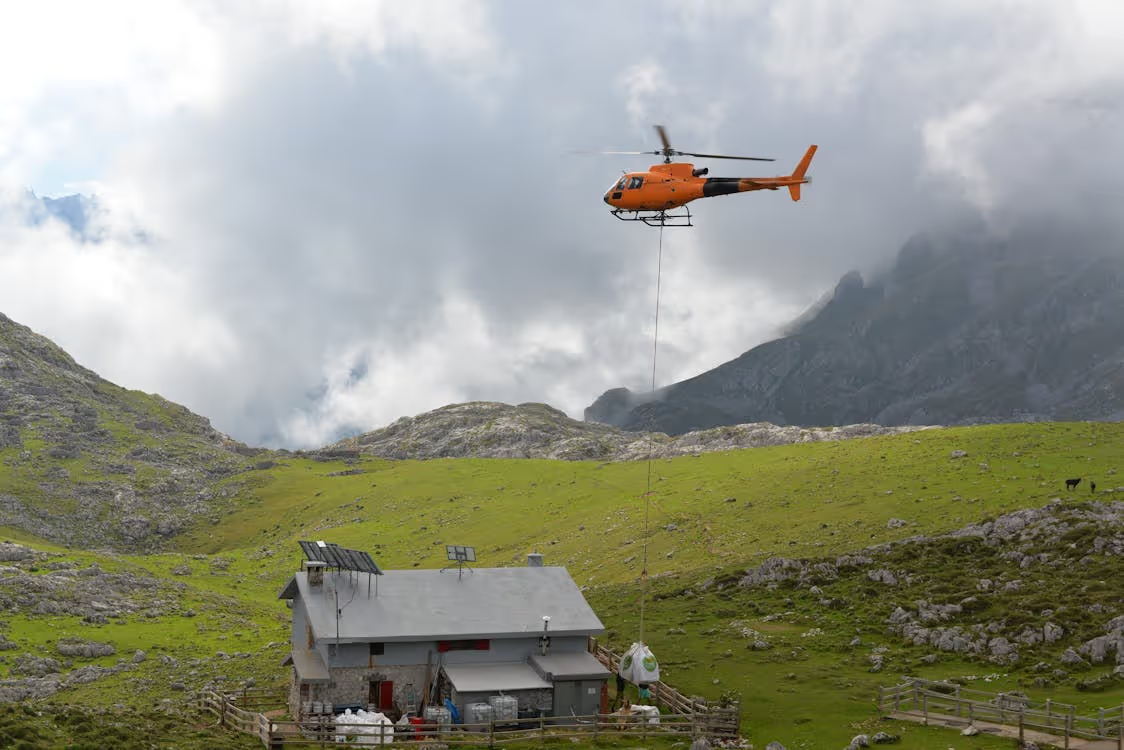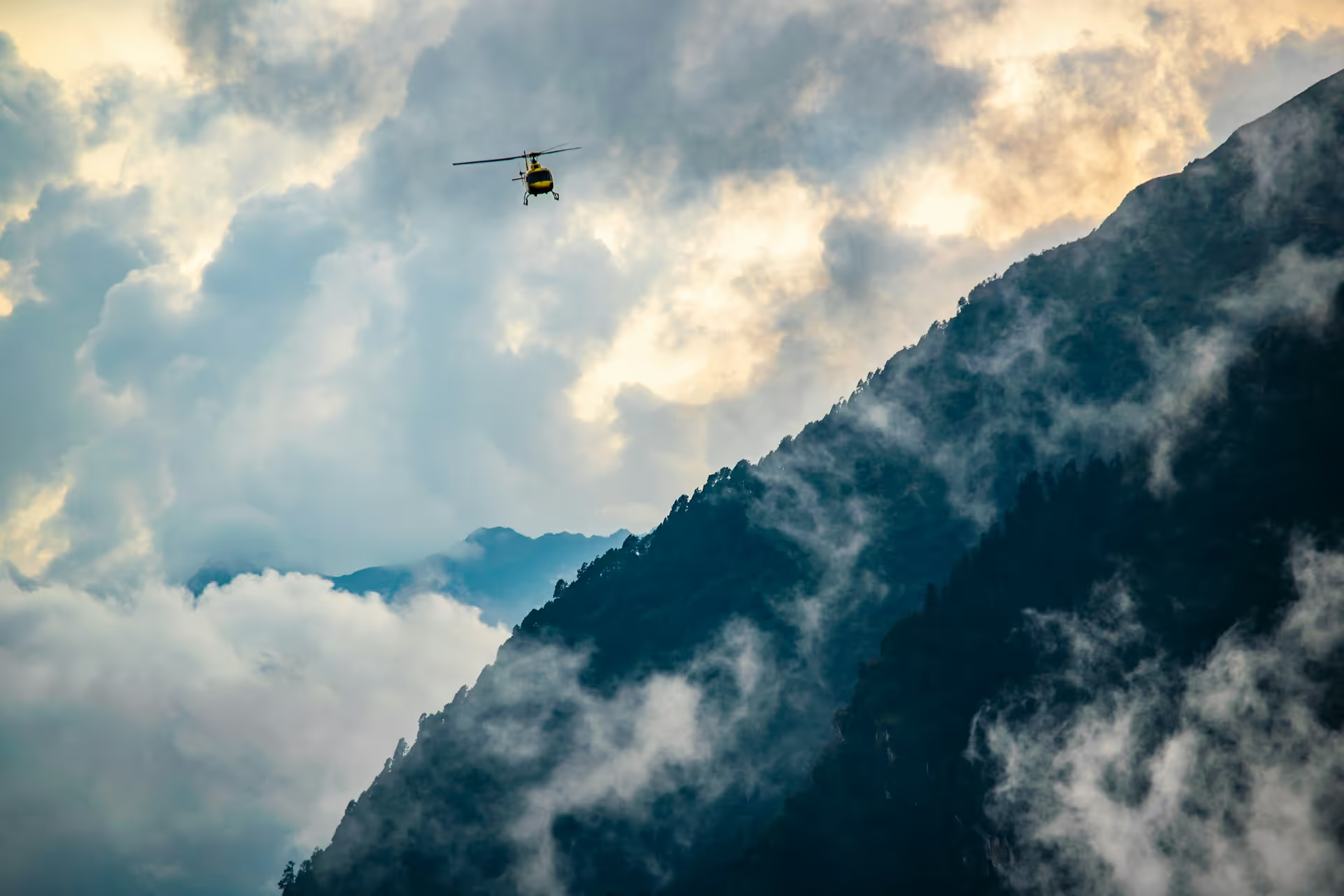Mountainous regions demand respect, specialized equipment, and highly skilled teams who can quickly adapt to changing conditions and perform with precision in some of the most challenging environments on Earth.
Whether your mission involves flying into the wilderness to rescue lost hikers or installing a ski lift on a remote peak, helicopters are often the only practical solution for high-altitude operations. But mountainous terrain is one of the most complex environments for helicopter-assisted operations.
Let’s break down some of the real-life applications of high-elevation helicopter services, the technical challenges of alpine operations, and how trained and experienced helicopter teams work to overcome them. No matter the type of work you do, this blog will show you how to pursue helicopter-assisted mountain operations with confidence.
Real-Life Applications of Mountain Operations
High-altitude helicopter operations span a wide range of industries. These aircraft support critical missions, from search and rescue to scientific research (and everything in between).
Search and Rescue Operations
When people get lost or injured in remote, mountainous regions, search and rescue teams are called upon to locate them and administer aid as swiftly as possible. Helicopters are capable of quickly reaching areas that are largely inaccessible by other means, aiding aerial searches, and being configured with the hoisting devices necessary to perform lifesaving rescue missions.
Medical Evacuations
Medical emergencies in remote locations with extreme elevation can be life-threatening without quick transport to a hospital. Emergency helicopter services are often the only way to safely evacuate injured individuals to nearby medical facilities where their illnesses and injuries can be treated.
Construction and Utility Projects
Helicopters can lift, transport, and place heavy materials and equipment with extreme precision in difficult terrain, like hilly or forested landscapes. They often support the construction of ski lifts and bridges as well as the placement of utility poles and cell towers in areas that would be difficult and time consuming to reach via other means.
Logging Operations
Helicopters offer an efficient solution for extracting timber from steep mountain slopes where traditional ground access is either impractical or too disruptive to the surrounding environment. “Heli-logging” – logging that uses aerial cranes and their attached cables to lift and remove cut trees from forests – helps minimize soil disturbance, reduces the need for roads, and protects sensitive ecosystems.
Scientific Research
Scientific research frequently takes place in high-altitude environments, as scientists often need to study geology, climates, wildlife, and more in challenging locations. Helicopters provide safe and quick access to these areas, efficiently transporting personnel, equipment, and supplies while navigating rugged terrain that would be difficult (or impossible) to reach by ground.
Military Operations
Mountainous terrain is a frequent setting for specialized military operations and training missions. Helicopters play a key role in transporting personnel and equipment to these difficult environments.

Why High-Altitude Work Is Especially Challenging
Mountain operations test every aspect of a helicopter team’s training, fleet, and equipment. That’s because the thinner air and rough terrain of high-elevation environments impact how helicopters perform.
Here are three key challenges that helicopter crews must overcome when working in vertical terrain:
- High Density Altitude: As altitude increases, air density drops. This thinner air can reduce a helicopter’s lift capacity and impact its engine performance. Because there is less thick air for blades to push against, rotors must work even harder, and pilots must maintain constant situational awareness to avoid obstacles and sudden shifts in terrain.
- Unpredictable Weather: Sudden changes in wind, visibility, and turbulence are common at high elevations – and can be particularly dangerous.
- Confined Landing Zones: Finding safe landing zones on narrow ridgelines or in tight valleys can be exceptionally difficult. Helicopter pilots must be confident landing in confined areas with near surgical precision.
How Experienced Helicopter Teams Tackle High-Altitude Challenges
Certified and experienced helicopter crews, like the team at Helicopter Express, use a combination of specialized training, in-air experience, and safety protocols to manage the complexities of mountain operations.
Proper Training and Education
Pilots and their teams operating in elevated regions must be properly trained in high-altitude flying to ensure safety and precision in difficult environments. This includes executing slow, controlled approaches to maintain lift and using natural barriers like trees to help gauge elevation and descent angles.
A deep understanding of mountain wind patterns and weather is essential, as is an understanding of helicopter performance in high-elevation environments – like how altitude impacts the aircraft’s limitations and handling.
Experience in the Field
Nothing replaces time in the air. Experienced pilots know how to efficiently manage helicopter power to avoid overstressing the engine in thinner, high-altitude air. They also know how to anticipate and navigate terrain challenges with confidence, even in tight or severely sloped zones.
Risk Assessments
Before every mission in steep elevation zones, helicopter crews must conduct detailed risk assessments that account for weather conditions, wind patterns, weight calculations, and more. These evaluations help crews anticipate potential hazards, select the safest flight paths, and make critical decisions that ensure the safety of both personnel and equipment throughout the operation.
Contingency Plans
It’s essential that helicopter crews develop contingency plans, including alternate flight routes and emergency landing sites, in case conditions change unexpectedly mid-operation.
Pre-Flight Inspections
Thorough pre-flight inspections are crucial to ensure all aircraft systems and equipment are fully prepared for the demands of rugged terrain.
These checks often include:
- Verifying engine performance in low-oxygen environments
- Inspecting rotor blades for potential stress damage
- Ensuring proper calibration of navigation and communication tools
- Confirming that all emergency and survival gear is securely stowed and operational
Crew Coordination and Communication
Clear communication between pilots, aerial crews, ground crews, and air traffic control is critical during tight landings and lifts. It’s essential that everyone understand their role and specific tasks before and during flight.
Specialized Equipment
Certain helicopters are better equipped to perform more efficiently in thinner air, and specific gear and equipment designed for rugged and unpredictable conditions may be necessary.
This might include:
- High-altitude rotor systems
- GPS and terrain-following navigation systems
- Rescue hoists, cargo nets, longline, and sling load gear
- Advanced communication systems
- Emergency medical equipment
Each piece of specialized equipment plays a critical role in ensuring mission success in difficult terrain.
Adherence to Strict Safety Protocols
Mountain operations leave no room for shortcuts. Reputable and experienced helicopter service providers should follow all FAA regulations and internal safety protocols (maintaining minimum altitudes, monitoring changing weather conditions, etc.) to prevent unnecessary risks and keep crew members safe.

Choosing the Right Helicopter Partner for High-Altitude Missions
Not every helicopter service company is trained and equipped to handle high-altitude missions in challenging weather and tough terrain.
Here’s what to look for as you evaluate your options:
- Elite Pilots: Confirm that the team has experienced pilots who are specifically trained in mountain flying.
- Proven Experience: Ask about past projects in vertical terrain or at high altitudes.
- Customized Project Plan: Every mission is different. The right partner should work closely with you to develop a comprehensive plan, considering your project scope, location, timeline, and budget.
- Strong Communication: Clear and transparent communication is a must for safety and success.
- Top Safety Ratings: Never compromise on safety. Ask about their safety record and maintenance protocols.
Partner With Helicopter Express for Successful Mountain Operations
Helicopter Express has supported high-altitude missions across the U.S. and overseas. Our experienced pilots, versatile fleet, and deep commitment to client success have made us the trusted choice for challenging mountain work for over three decades.
Whether you need support for a construction project, search and rescue mission, or anything in between, our team is ready to help you rise to the challenge. Together, we can tackle any mission safely and efficiently.
If you’re ready to plan your high-altitude operation, contact Helicopter Express today.

